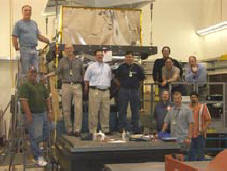
Handy Links
SLAC News Center
SLAC Today
- Subscribe
- Archives: Feb 2006-May 20, 2011
- Archives: May 23, 2011 and later
- Submit Feedback or Story Ideas
- About SLAC Today
SLAC News
Lab News
- Interactions
- Lightsources.org
- ILC NewsLine
- Int'l Science Grid This Week
- Fermilab Today
- Berkeley Lab News
- @brookhaven TODAY
- DOE Pulse
- CERN Courier
- DESY inForm
- US / LHC
SLAC Links
- Emergency
- Safety
- Policy Repository
- Site Entry Form

- Site Maps
- M & O Review
- Computing Status & Calendar
- SLAC Colloquium
- SLACspeak
- SLACspace
- SLAC Logo
- Café Menu
- Flea Market
- Web E-mail
- Marguerite Shuttle
- Discount Commuter Passes
-
Award Reporting Form
- SPIRES
- SciDoc
- Activity Groups
- Library
Stanford
Around the Bay
Researchers Test LAT in D.C.
 SLAC's involvement with the Large Area Telescope (LAT) didn't end the day it left the lab.
In mid-May, when the telescope arrived at the Naval Research Laboratory (NRL) in Washington, D.C.,
SLAC employees were there to greet the instrument. The crew was part of a larger SLAC contingent that will
regularly spend time in D.C. during LAT's pre-launch testing.
SLAC's involvement with the Large Area Telescope (LAT) didn't end the day it left the lab.
In mid-May, when the telescope arrived at the Naval Research Laboratory (NRL) in Washington, D.C.,
SLAC employees were there to greet the instrument. The crew was part of a larger SLAC contingent that will
regularly spend time in D.C. during LAT's pre-launch testing.
At NRL, the LAT will undergo tests of vibration, electromagnetic interference, acoustic shock and temperature extremes. The LAT has already passed the first two of these tests. The vibration test subjected the instrument to vibrations that are in excess of the levels it will experience during the rocket launch, while the interference test ensured that the radio waves the LAT emits will not upset the spacecraft, and vice versa. For the acoustic test, NRL will use a facility that blasts the LAT with high intensity sound through the four octaves at 147 decibels to prove that the acoustic shock of takeoff will not harm the instrument. (By comparison, the threshold of human pain is 120 dB.) Finally, the LAT will be subjected to temperature extremes in a vacuum to simulate the harsh environment of space.
Before the final round of tests can begin, the crew will have to move the LAT. During initial testing, the instrument was oriented vertically (the same orientation it will have on top of the rocket). But for the final tests, two cranes must maneuver the three-ton telescope into a horizontal position. Before they attempt this feat, a crew will practice with a plywood mock-up of the telescope—complete with a well-placed three ton block of steel to simulate the LAT's mass at its center of gravity. Each maneuver takes at least an hour.
"You can't be too careful with an object when you've spent $150 million," says Lowell Klaisner, LAT Project Manager.
The telescope is the primary instrument on GLAST, the Gamma-ray Large Area Space Telescope observatory, that will detect gamma rays from distant celestial objects to help answer questions about the early universe.
—Krista Zala
SLAC Today, June 28, 2006
Image: SLAC researchers pause for a photo after installing the LAT on top of NRL's Vertical Vibration Fixture. (Click on image for larger version.)